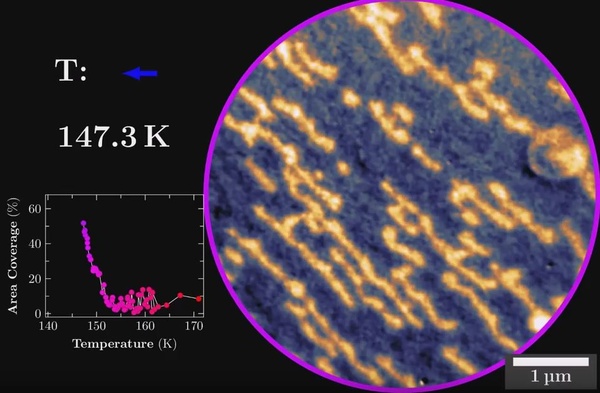|
a team of european scientists led by researchers at the delft university of technology (tu delft) in the netherlands have been able to detail how phase change propagates in solid state nickelates, which is a material that considered for future electronics.

tu delft researchers witrnessed the phase change of nickelates. (youtube)
the scientists knew that phase change in nickelates was dual, according to a report from the university, in that temperature changes the material’s electronic and magnetic properties, but using a precisely tuned x-ray light to magnify the material allowed the scientists to watch the change from metallic to insulating state in real time.
the results of the study were that as the material is cooled “insulating nano-domains gradually start to appear, until the material is covered with tiny, insulating stripes.”
in order to view the process, the researchers deposited the nickelate think film onto a substrate and it was determined that the shape of the substrate surface impacted how the nickelate transitioned from metallic to insulator. “if the surface had square holes, for example, the domains would have been the shape of squares,” the article explained.
additional research will be conducted using a laser to force the material to switch phase instantly to demonstrate the ability to turn magnetism and conductivity on and off with a switch. “potential future electronics could, for instance, use nickelate structures as light-controlled ultra-fast transistors,” according to the article.
the research was recently published in nature communications. the abstract read:
“nucleation processes of mixed-phase states are an intrinsic characteristic of first-order phase transitions, typically related to local symmetry breaking. direct observation of emerging mixed-phase regions in materials showing a first-order metal–insulator transition (mit) offers unique opportunities to uncover their driving mechanism.
“using photoemission electron microscopy, we image the nanoscale formation and growth of insulating domains across the temperature-driven mit in ndnio3 epitaxial thin films. heteroepitaxy is found to strongly determine the nanoscale nature of the phase transition, inducing preferential formation of striped domains along the terraces of atomically flat stepped surfaces.
“we show that the distribution of transition temperatures is a local property, set by surface morphology and stable across multiple temperature cycles. our data provide new insights into the mit of heteroepitaxial nickelates and point to a rich, nanoscale phenomenology in this strongly correlated material.”
the phase-change process can be viewed in the video below:
|